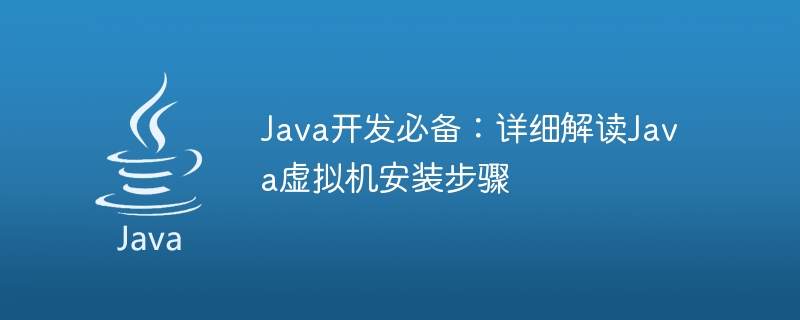

Necessary for Java development: Detailed explanation of Java virtual machine installation steps, specific code examples are required
With the development of computer science and technology, Java language has become widely used One of the programming languages. It has the advantages of cross-platform and object-oriented, and has gradually become the preferred language for developers. Before using Java for development, you first need to install the Java Virtual Machine (JVM). This article will explain the installation steps of the Java virtual machine in detail and provide specific code examples.
The Java virtual machine is the core component of the Java Runtime Environment (JRE). It is a virtual computer that can convert Java bytecode into machine code and execute it. Installing a Java virtual machine can provide developers with a platform to execute Java programs.
1. Download the Java Development Kit (JDK)
Before installing the Java virtual machine, you first need to download the Java Development Kit (JDK). JDK is the basis for Java developers to develop Java applications, including a Java compiler and other necessary tools and libraries.
1. Visit Oracle’s official website (https://www.oracle.com/java/technologies/javase-jdk12-downloads.html).
2. Select the appropriate JDK version to download according to your operating system. For example, for Windows 64-bit systems, choose the Windows x64 version.
3. Click the download link and save the JDK installation package to the local directory.
2. Install the Java Development Kit (JDK)
After the download is completed, start installing the Java Development Kit.
1. Find the downloaded JDK installation package in the local directory and double-click to run it.
2. Follow the prompts of the installation wizard to select the installation path and other options. It is recommended to install the JDK to the default path.
3. Wait for the installation to complete and open a command line window (Command Prompt or PowerShell in Windows).
3. Verify the installation results
After the installation is completed, you need to verify whether the Java virtual machine is successfully installed and configured.
1. Enter the following command in the command line window to view the version information of the Java virtual machine.
java -version
If the following content is displayed, the Java virtual machine has been successfully installed.
java version "12.0.1" 2019-04-16
Java(TM) SE Runtime Environment (build 12.0.1 12)
Java HotSpot(TM) 64-Bit Server VM (build 12.0.1 12, mixed mode, sharing)
2. Enter the following command in the command line window to view the installation path of the Java virtual machine.
where java
If the following content is displayed, the installation path of the Java virtual machine is correct.
C:Program FilesJavajdk-12.0.1 injava.exe
At this point, the installation of the Java virtual machine has been completed. Next, Java programs can be written and executed.
4. Writing and Executing Java Programs
In order to demonstrate the use of the Java virtual machine, a simple Java program is given below to add two numbers and output the result.
1. Use any text editor to create a file named Addition.java, and copy and paste the following code into the file.
public class Addition {
public static void main(String[] args) {
int num1 = 5;
int num2 = 10;
int sum = num1 + num2;
System.out.println("The sum of " + num1 + " and " + num2 + " is " + sum);
}}
2. Save the file and make sure the file extension is .java.
3. Enter the directory where the file is saved in the command line window.
4. Enter the following command to compile the Java source file.
javac Addition.java
5. Enter the following command to execute the compiled Java program.
java Addition
If all goes well, the command line window will display the following.
The sum of 5 and 10 is 15
At this point, the installation and configuration of the Java virtual machine has been completed, and a simple Java program has been successfully written and executed.
Summary
This article explains the installation steps of the Java virtual machine in detail and provides specific code examples. By downloading and installing the Java Development Kit (JDK), verifying the installation results, and writing and executing Java programs, developers can smoothly start developing using the Java virtual machine. I hope this article will be helpful to Java development beginners and related practitioners.
The above is the detailed content of Comprehensive Guide: Detailed Java Virtual Machine Installation Process. For more information, please follow other related articles on the PHP Chinese website!